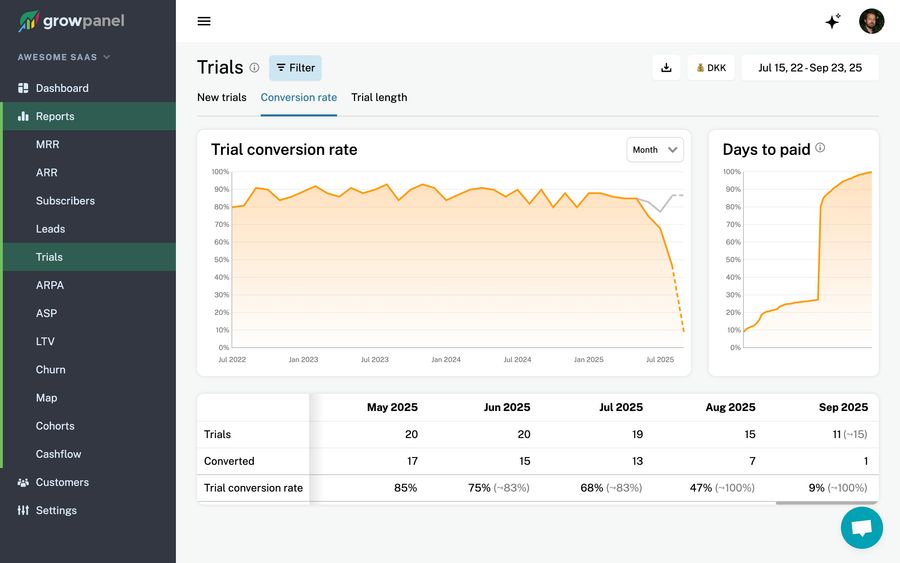Designing the perfect SaaS trial

Designing the right free trial is one of the most overlooked growth levers in SaaS. It shapes your acquisition funnel, conversion rate, payback period, and even your churn profile – yet many teams still pick a trial length by gut feeling. Some choose 14 days because "everyone else does." Others go for 30 days because "it feels generous." Both can be wrong.
The right trial length depends on how quickly your product delivers value, the complexity of your onboarding, and your go-to-market model – product-led, self-serve, or enterprise. Recent academic research and hundreds of real-world experiments have made this much clearer, and the data tells a consistent story: shorter trials often create urgency and higher early conversions, while longer trials encourage adoption and delayed conversions, particularly for complex products.
In this article, we'll break down what the research says, how to choose the right trial length for your SaaS, what should happen after the trial ends, and when (and how) to extend or discount. You'll also see how GrowPanel visualizes trial performance with metrics like average trial length and days-to-conversion – data that helps you find the sweet spot between time-to-value and conversion.
What the research says about trial length
A large randomized field experiment published in Frontiers in Psychology (Zhang & Duan, 2025) tested different trial durations across 680,000 users. The results were striking: extending trials led to higher adoption and more delayed conversions, but not necessarily more immediate conversions. In simple terms, longer trials pulled in more people but didn't make them buy faster.
Earlier work from Yoganarasimhan (2023) found similar patterns. Short trials create a sense of urgency; long trials help users explore. The "best" duration depends on how fast a user experiences the first moment of value.
See also this blog post about trial length
The best trial length isn't about generosity. It's about how long it takes for your product to prove its value.
This brings us to one of the most important SaaS metrics: Time-To-Value (TTV).
The famous 'aha' moment
Time-To-Value (TTV) is the number of days it takes for a typical user to experience their first meaningful outcome after starting a trial. In analytics tools, that might be the first dashboard created; in billing software, the first invoice sent; in project management, the first task completed with teammates.
If your product takes 14 days to reach the ‘aha' moment, offering a 7-day trial is self-sabotage. But if users hit value in 2 days, giving them 30 days is just paying for server costs.
Choosing the right trial length
The data and practitioner consensus converge around a few concrete benchmarks:
- Self-serve or PLG tools: 7–14 days. These products typically deliver value quickly and benefit from a clear decision window. A shorter trial amplifies urgency and helps users commit before enthusiasm fades.
- Mid-market or technical products: 14–30 days. If your tool requires integrations, setup, or team collaboration, users need more time to experience value.
- Enterprise products: 30–90 days. These trials usually function as guided proof-of-concepts or sandboxes, with sales support and defined success criteria.
The right duration balances two opposing forces:
- Urgency: shorter trials drive faster action and clearer sales signals.
- Adoption: longer trials increase completion of onboarding and collaborative use.
Most SaaS companies find that beyond 30 days, trial-to-paid conversion rates flatten. You may still see delayed conversions (users who upgrade months later), but the marginal ROI of a longer trial is low.
What should happen after the trial ends
Your trial doesn't end when the clock hits zero. In fact, most conversions happen around the expiry date, not before. The days after trial expiry are a critical opportunity to convert high-intent users and re-engage the rest.
A good post-trial sequence combines automation and personalization.
- At expiry: send a clear, value-focused message. Instead of "Your trial has expired," say "Your trial ended – here's what you built." Include metrics: reports created, integrations connected, or data processed.
- Day 3–5: follow up based on behavior. If the user reached activation, invite them to a 15-minute onboarding call. If not, share a short tutorial or success story.
- Day 10–14: send a final nudge – possibly with a time-limited incentive for active but unconverted users.
The best post-trial emails don't talk about the trial. They talk about progress. Show the user what they've achieved – and what they'll lose if they don't continue.
Should you allow trial extensions?
Trial extensions can be powerful when used selectively. A user asking for more time isn't always a good lead – but when someone is clearly engaging, an extension can push them across the line.
Here's what works best in practice:
- Offer extensions only to users who are active and progressing. For example, if they completed 80% of onboarding or used key features in the past week.
- Require a micro-commitment: schedule a demo, complete a setup task, or fill out a brief survey. This ensures extensions are granted to serious prospects.
- Avoid blanket policies like "anyone can extend once." They create passive behavior and lower urgency.
"A trial extension should feel like a reward for progress – not a lifeline for indecision."
Should you give discounts after expiry?
Discounting is one of the trickiest levers in SaaS. It can work, but only when targeted.
Automatic discounts on trial expiry tend to devalue the product and train users to wait for cheaper pricing. However, targeted win-back offers work well when based on engagement data. If a user clearly reached value but didn't convert, a limited-time incentive can reactivate them. The difference is intent: discounting should nudge someone already sold on the product, not bribe someone who never started.
In one of the SaaS companies I invested in, we ran an experiment: users who had created at least two dashboards but didn't upgrade received a "Welcome back" offer two weeks after expiry. Conversion from that group increased by 18%, and churn stayed consistent with the control group. Blanket discounts for everyone, on the other hand, performed worse and reduced average revenue per user.
How to visualize trials in GrowPanel
Inside GrowPanel, trial metrics are treated as a first-class citizen. We automatically track trial start, activation, conversion, and expiry – and we visualize how users move through each stage.
The Days-to-Conversion Chart shows the cumulative share of final conversions that occur on each day of the trial. It's one of my favorite charts for optimizing trial strategy.

If you see that 80% of all conversions happen by day 10, then a 30-day trial is probably wasting time and server cost. Conversely, if conversions continue steadily until day 25, shortening the trial could harm revenue.
We also show Average Trial Length by Plan or Segment, which helps you understand if certain plans, geographies, or acquisition channels require more time to convert. When combined with GrowPanel's Time-to-Value and Trial-to-Paid metrics, you get a complete picture of where your funnel friction lives.

"The right trial length isn't a decision you make once. It's something you measure continuously – until the data tells you it's time to change."
Practical defaults
If you need a starting point, these settings work well for most SaaS businesses:
- Product-led / self-serve: 10-day trial, no credit card required, strong onboarding and in-app activation cues. Expect 10–25% trial-to-paid depending on your niche.
- Mid-market or technical SaaS: 21-day trial with onboarding checklist, automated emails, and clear "aha" milestones.
- Enterprise or sales-assisted: 30–90 day sandbox or POC, tied to measurable success criteria and a sales follow-up process.
Whatever your model, remember that trial design is a living experiment. Use data from GrowPanel (or your own analytics) to compare cohorts, visualize days-to-conversion, and test changes scientifically.
Final thoughts
A well-designed trial is not about generosity. It's about clarity. The goal isn't to give users as much time as possible – it's to give them just enough time to experience value, build confidence, and decide.
If you shorten your trial and make onboarding better, your conversion rate may rise without touching pricing. If you extend it strategically for users showing promise, you'll convert more high-value accounts without losing urgency. And if you monitor your trial data – days-to-conversion, activation rate, and Time-To-Value – you'll know exactly where to focus next.
"Trials don't create demand. They reveal it. Your job is to remove the friction between curiosity and conviction."

Lasse Schou
Lasse is the founder of GrowPanel and an entrepreneur with 25 years of experience building SaaS businesses. After a successful exit from his previous SaaS company, he now invests as an angel in promising SaaS startups.
